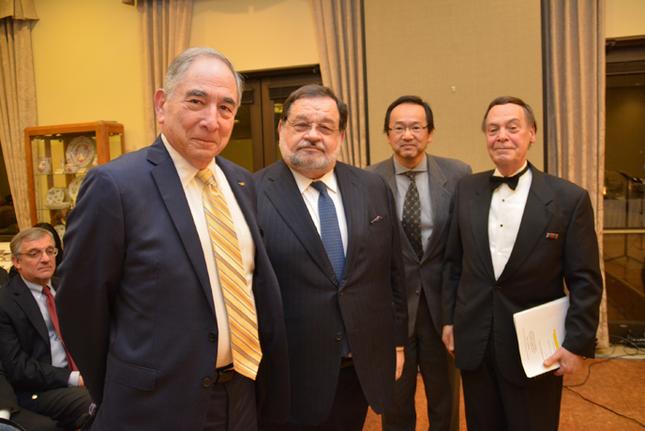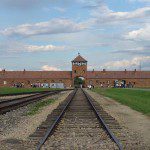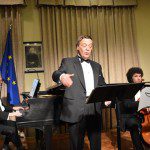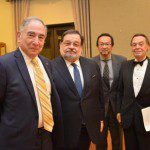A Tribute to the Lives Lived and Lost at the Holocaust Museum
By • February 5, 2015 0 1768

Just earlier that day, Holocaust survivor Manny Mandel had recited the Kaddish, the traditional Jewish prayer often said by way of mourning at the U.S. Holocaust Museum where candles were lit and music played and dignitaries spoke in observance of International Holocaust Remembrance Day. The day also happened to be the 70th anniversary of the liberation of Auschwitz, the infamous Nazi death camp where millions of the over six million Jews who perished in the Holocaust died.
And Mandel was there at the Embassy of Hungary that evening to once again recited the Kaddish as part of a special evening at the embassy, which included a deeply diverse, and often emotionally wrenching concert presented by the Embassy Series. The concert featured baritone Jerome Barry (the Embassy Series founder and director), the gifted and young cello player Jacques-Pierre Malan, and pianist George Peachey, who provided a steady and solid underpinning for much of the program.
Mandel and Barry noted that the Kaddish, in this instance, was not about death, but about life and the living, and about the how the incomprehensible number of lives lost were lived.
Auschwitz was the place where approximately half-a-million Hungarian Jews perished in a steady stream of shipments and deportations from Hungary in the Nazis’ last act of horror toward the close of World War II, never stopping in their pursuit of the Final Solution. This occurred in spite of often heroic efforts by many Hungarians to stop, delay or prevent the tragedy.
It was an auspicious evening at the Embassy of Hungary—this was the last official evening for Hungarian ambassador to the United States, His Excellency György Szapáry, who is returning to Hungary on Saturday, Jan. 25.
If the Kaddish is about life, not death, then the concert and its contents—like a mural, a book, a packet of all the lost things the victims carried, including the substance of their lives—became something of a perfect illustration of life, not death.
The concert included musical poems, dances, children’s songs and Hassidic Prayer Chants, three selections from a rabbi’s commentaries on the Talmud, musical memories of childhood, in the manner of E. E. Cummings and the true spirit of young hearts flying, songs from the Holocaust, vivid evocations of life in the ghettos and camps of Poland and Vilna in Lithuania and the so-called Partisanerlid (Partisans’ Song), which members of the resistance sang like a loud but private badge.
Words, in these selections of music, mattered—they conjured weather, nights and days, the ashes in the air, the danger of daily existence, the grind of death and loss, and the spring-insistence on the continuance of life amid the systematic onslaught of destruction.
The concert, or rather the recreation all of the individual lives lost with words and music, was a remarkable achievement of the playing, the singing and the creation of music as a reverent, respectful illustration of content.
Barry, a teacher, singer, cantor, linguist and Vietnam veteran rose to the occasion by treating the material—those songs, those recitations, those poems—with a natural delivery without an inkling of emotive style. The singing was not about calling down the sky or even bearing overbearing witness. It was more an expression of universal kinship. It came from identity, training, experience and empathy that flowed naturally to and from him.
The youthful and gifted cellist Malan brought the strength and depth of the instrument to bear, especially in the playing, with Peachey, of Gabriel Fauré’s “Elegie,” which was described by one writer as the composer’s rare “expression of pathos.”
The concert—dedicated to the victims of terrorism in Paris and the Holocaust—was not an occasion that was principally an opportunity to critique. It seemed to many a kind of work of delicate musical carpentry, built piece by piece from not only the music, and the words, but from the details of lives lived and lost forever. It came from hard nights, pieces of bread rarely received, long journeys to doom, but also still the familial and familiar stuff of daily life, where God is, in spite of all, a strong presence, visible in the invisible, in a pair of shoes, in a stick made to be a toy, in the kind of mark, Pompeii-like, made by the living where they stood, prayed, ate, shivered and comforted each other in community.
Consider the works by Hungarian poet Hannah Szenes, who was killed by the Nazis in 1944: her work “Eli, Eli;” “My God, My God/May these things never end;” “The sand and the sea/The rustle of the water/The lightning in the sky/Man’s prayer.”
The concert veered and trembled through three piano dances, songs from the Holocaust including the familiar Ani ma’amin, believed to have been composed by Reb Azriel David, a Moditzser Hassid when he was in a cattle car on the way to Treblinka. ?
The musical details piled up, like remembrances left at shrine, but living memories, not dead flowers, and the marvel that people in the midst of all this still thought to look up at the sky.
Many of the musical offerings were sung in Yiddish, with an ironic underpinning, in which you notice how familiar it sounds, how close to German en toto, in consonants and vowels they are and you wonder again how we came to this in that time, and how it echoes to this time, a time of technological wonders, and new horrors.
- Manny Mandel, Ambassador of Luxembourg Jean-Louis Wolzfeld, Ambassdor of Hungary Gyorgy Szapary and Jerome Barry. | Morris Simon





